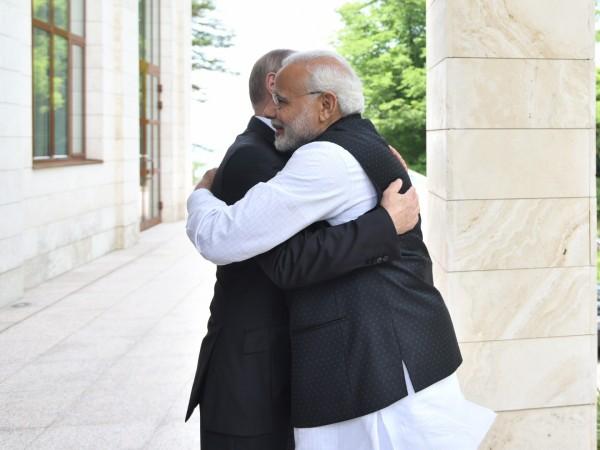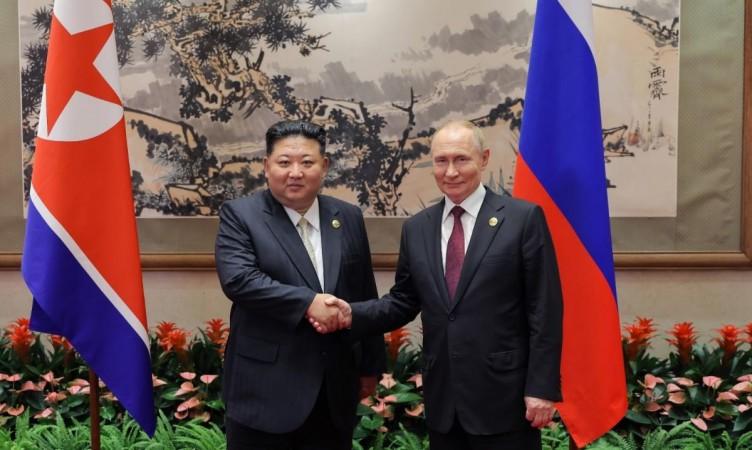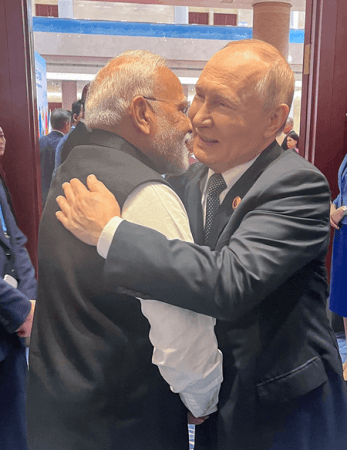
In October 2025, the world watched as Russian President Vladimir Putin issued a stark warning: should the United States supply Ukraine with Tomahawk cruise missiles capable of striking deep into Russian territory including Moscow-U.S. Russia relations would be "destroyed," and the conflict would enter a "qualitatively new stage" of escalation.
This declaration arrived just as the Trump administration is reported to be weighing approval of Ukrainian requests for long-range Tomahawk weapons though U.S. sources caution that inventory constraints and geopolitics may hobble any actual transfer.
That tension , the prospect of Tomahawks crossing the threshold, balanced against real constraints and risks is now the opening chord for a much larger symphony. It's not simply a weapons-supply decision: it is a pivot in global deterrence norms, a test of alliance cohesion, and a pressure point in Eurasian strategy. With that news hook laid, we can now examine the full strategic stakes, the likely counterplays from Moscow, and the discipline India must maintain to navigate this turning moment.
The debate over long-range cruise missile transfers particularly the U.S. Tomahawk to Ukraine has now become a defining fault line in the evolving geostrategic architecture of 2025. It is not merely a question of military hardware; it is a confluence of industrial capacity, escalation management, alliance dynamics, regional balance, and strategic identity. For Moscow, Washington, Kyiv, and third-party states such as India, what happens in the coming weeks could reshape deterrence, capability norms, and strategic autonomy for years.
1. The U.S. Decision: Constraints, Calculus, and Emerging Signals
Inventory & Industrial Constraints
Tomahawks are expensive and complex: unit costs run into millions of dollars; production rate is modest (recent U.S. plans show annual procurement in the tens of missiles, and inventories already committed to U.S. Navy operations).
The U.S. is modernizing Block V variants, including maritime strike seeker versions. Even so, producing enough missiles to satisfy both U.S. strategic requirements and transfers to allies imposes trade-offs. (A diversion to Ukraine could stretch supply chains, readiness, and budget ceilings.)
Enhancement: According to the Pentagon, the U.S. currently maintains approximately 2,500 Tomahawk missiles, with annual Block V production of roughly 50–60 units. Diverting even a small tranche to Ukraine could require reprioritizing domestic deployment and modernization programs.
Political & Escalation Calculus
Moscow has already warned in unambiguous terms: supplying Tomahawks would amount to a "qualitatively new stage of escalation," with threats to sever "positive trends" in U.S.–Russia relations.
There is internal U.S. debate: some voices push for more aggressive support to Ukraine; others caution that deep-strike weapons against Russian territory risk either kinetic retaliation, asymmetric responses, or even nuclear signalling.
> "The introduction of long-range precision strike systems into a conflict is not merely military it is a test of political will, crisis management, and alliance coordination." - Dr. Michael O'Hanlon, Brookings Institution
Alternative Measures & Enabling Support
Even without transferring Tomahawks, the U.S. has begun shifting policy: providing intelligence for long-range missile strikes on energy infrastructure in Russia. Potentially enabling European allies to acquire long-range strike capabilities which could be transferred to Ukraine. This would allow somewhat indirect support, diluting the risk of U.S. direct escalation while maintaining assistance.
2. Russian Imperatives: Threat Management, Response Strategy, and Risk Balancing
Key Russian Strategic Goals
Preserve deterrence at home: Moscow must convince its domestic audience and adversaries that its rear areas and strategic depth remain inviolable or rapidly defensible.
Maintain diplomatic leverage: Use escalation rhetoric to impose political cost on Western states considering the transfer, to fracture alliances or raise the bar for intervention.
Manage risk: Avoid being pushed into over-escalation that could trigger broader NATO involvement or provoke responses in Europe or beyond.
Likely Response Options
Air-defense envelope intensification: Accelerate deployment and integration of long-range air/missile defense systems, electronic warfare, counter-battery systems to intercept, degrade or deter cruise missile usage.
Asymmetric retaliation: Use drones, missile strikes, and cyberattacks against critical infrastructure, logistics nodes, or soft targets associated with supplying or enabling Ukraine. Possibly also increased operations targeting forward bases or support facilities.
Hybrid/diplomatic pressure: Intensify propaganda, diplomatic outreach to allies of the U.S./Ukraine; economic countermeasures; warnings of possible nuclear ambiguity or threats if escalation thresholds are crossed.
"Russia's challenge is balancing credible deterrence with escalation control. Missteps could isolate Moscow strategically while energizing Western support for Kyiv." - Former Russian General Leonid Ivashov
Risks Russia Faces
Cost of escalation: escalation might lead to stronger Western air defence systems being deployed closer to Russian borders, formation of new coalitions, or expanded military aid to Ukraine.
Domestic vulnerability: degradation of energy infrastructure, supply chain disruption, public dissatisfaction if internal disruptions intensify, especially in fuel shortages.
Reputation and foreign relations: if escalation leads to outright conflict with NATO partners or wider economic penalties, Moscow's global posture could suffer.
3. Implications & Imperatives for India: Strategic Autonomy in a Volatile Landscape

Why it matters for India
India's geostrategic environment is already complex—with China's rise, a volatile Pakistan, and shifting U.S., Russian, and Chinese dynamics. Developments in Ukraine reverberate globally: what is "escalation" in Europe could become precedent in Asia.
India's defence supply chains increasingly depend on imported precision strike systems, sensors, and missile technology. Observing how Tomahawk transfers are handled offers lessons in constraints, conditionality, and political risk.
There is both opportunity and risk: opportunity to diversify supply partnerships, build indigenous capacity; risk that being perceived as aligned to one side may reduce diplomatic space or invite countermeasures.
> "Strategic autonomy in a multipolar world is less about neutrality and more about calibrated engagement choosing where to align interests without forfeiting decision-making freedom." - Former Indian NSA Shivshankar Menon
Key Imperatives
Hardening and resilience first: Audit national critical infrastructure—ports, rail corridors, energy hubs—with an eye on stand-off missile threat profiles. Disperse, harden, build redundancy.
Expand and modernize layered air defence, including shorter and mid-range missile defense, and electronic warfare capabilities.
Intelligence, surveillance, and targeting resilience: Increase investment in ISR systems (satellite, UAV, ground sensors), data fusion, secure communications to detect incoming threats early and coordinate responses. Develop indigenous BDA (battle damage assessment) capability.
Defence industrial base surge and strategic supply chain sovereignty: Prioritize development of indigenous long-range strike systems, seekers, guidance, warheads. Fast-track projects under "Make in India". Diversify suppliers.
Legal and diplomatic clarity: Define red-lines and escalation thresholds in India's national doctrine. Maintain strategic autonomy through transparent diplomacy.
Contingency planning & military readiness: Exercises simulating stand-off missile attacks on infrastructure; civil-military cooperation in disaster response. Stockpile critical supplies: missile components, spares, fuel, munitions.
Strategic signaling & reputational discipline: Avoid ambiguous behavior that could be misinterpreted as escalatory alignment. Ensure export-controls and end-use monitoring are visible and enforceable.

4. Scenarios: What Might Unfold & What India Must Watch
Forecasted risk/opportunity for India
Scenario A – U.S. Restraint + Enabling Support
U.S. declines Tomahawk transfer but scales intelligence provision and supports European allies' long-range systems.
Ukraine's reach increases gradually; Russia intensifies air defence, hybrid retaliation; escalation remains diplomatic.
Opportunity: limited escalation gives India time to build defence readiness; ability to deepen cooperation with the U.S./Europe without overcommitment.
Scenario B – Selective Transfer to Ukraine
U.S. approves small tranche with strict conditions or allows allied states to reroute long-range missiles.
Moscow responds with threats, possible limited strikes, increased militarization of America's edges; NATO tightens joint defence posture.
Risk: diplomatic pressure on India to choose sides; heightened regional tension could affect supply relations, energy, trade; need to reinforce defence posture.
Scenario C – Full-Scale Transfer / Broad Western Long-Range Push
Coalition of Western states supplies long-range cruise missiles to Ukraine; U.S. supports permitting such transfers.
Significant removal of sanctuary zones in European Russia; sharp Russian counter-escalation; possibility of retaliatory attacks on support infrastructure; NATO becomes more forward postured.
High stakes: potential global realignment; India may face pressure from both sides; risk to supply chains (defence and energy); opportunity to assert independent foreign policy and strengthen deterrence.
Scenario D – Russian Escalation without U.S. Transfer
Moscow uses rhetorical/diplomatic warnings, but escalates unilaterally via strikes or hybrid warfare.
Front-line intensification; increased Russian attacks on Ukrainian energy, infrastructure; probing actions against supply routes or Western logistics.
For India: watch for spillovers in cyber, energy markets; possibility of indirect impacts via global energy/hydrocarbons; need for readiness even if not directly involved.
5. Conclusion: The Art of the Possible
The Tomahawk question is, in many ways, a proxy for broader questions of strategic decency, escalation control, and the future of Western deterrence posture. What is at stake:
Whether long-range standoff weapons can be transferred under strict conditions without triggering broader war.
Whether states like Russia are willing to absorb significant operational setbacks in return for diplomatic/political gains through fear of escalation.
Whether countries like India can preserve both strategic autonomy and alignment with norms of international order, while protecting their own interests in an increasingly unstable system.
> "States like India must observe and adapt this is as much a test of strategic judgment as it is of military capability." - Dr. Michael O'Hanlon
Final Prescription: A Course for Thoughtful Statecraft
For the U.S./Western allies:
Proceed with surgical assistance: enable Ukraine's deep reach through intelligence, allied procurements, and conditional transfers. Signal clearly to Russia what is permissible and what will trigger severe response.

For Russia:
Invest in hard defence, crisis communications, and internal resilience (economy, energy, legitimacy). Overreaction could isolate Russia further and accentuate vulnerabilities.
For India:
Defence readiness cannot be an afterthought: resilience, supply chain integrity, ISR capabilities, and layered air defenses are non-negotiable. Exercises simulating stand-off missile attacks, rapid mobilization drills, and civil-military coordination for infrastructure protection must be institutionalized.
Diplomacy must remain clear and strategically autonomous: balance relations with Russia, the U.S., and other key actors without appearing aligned to one side. Consistent messaging on peace, international law, and non-proliferation strengthens India's credibility.
Industrial base expansion: seize the opportunity to indigenize long-range strike systems, seekers, guidance, and sensors. Fast-tracking programs under "Make in India" ensures that the nation does not lag in precision-strike and missile technology domains, which are increasingly defining strategic relevance.
Strategic foresight and scenario planning: India must maintain multiple contingency plans covering cyber, energy, and conventional threats. Investments in BDA (battle damage assessment), ISR fusion, and secure communications will ensure rapid adaptation in crises.
The world is reconfiguring norms for precision strike, escalation thresholds, and alliance dynamics. For India, this is not merely a policy issue; it is a defining moment for strategic autonomy, industrial self-reliance, and defensive credibility.
Closing Reflection
The Tomahawk debate transcends its immediate military context. It is about thresholds, choice, and the exercise of strategic judgment. How states react will set precedent: for escalation management, alliance cohesion, and the preservation of sovereign decision-making.
For India, the imperative is clear: observe, prepare, and act with foresight. Strengthen the industrial base, fortify defenses, sharpen intelligence capabilities, and maintain unambiguous diplomatic positioning. Strategic autonomy is not passive; it is active, deliberate, and disciplined.
In a world where long-range precision weapons can instantly alter battlefield equations, where rhetoric can spiral into kinetic consequences, and where alliances are fluid, India's ability to maintain choice, credibility, and resilience will define its strategic posture for decades.
The Tomahawk debate is therefore not just about missiles. It is about the art of statecraft in an era of rapid technological escalation, where foresight, preparation, and disciplined action separate those who merely respond from those who shape outcomes. For India, now is the time to rise to that challenge.
[Major General Dr. Dilawar Singh, IAV, is a distinguished strategist having held senior positions in technology, defence, and corporate governance. He serves on global boards and advises on leadership, emerging technologies, and strategic affairs, with a focus on aligning India's interests in the evolving global technological order.]









